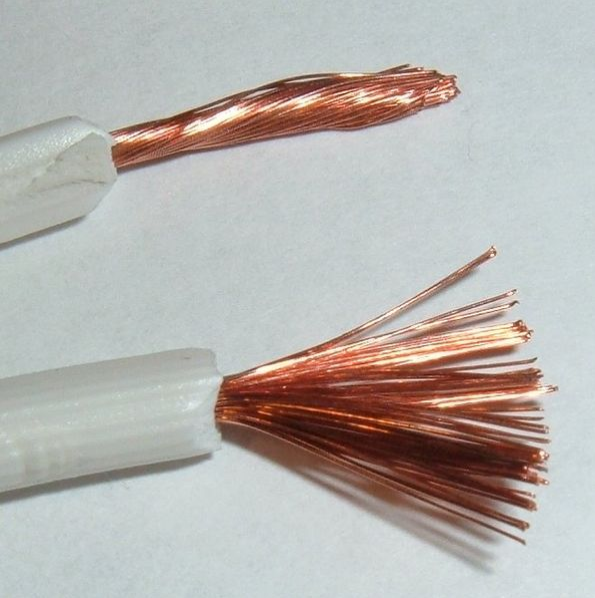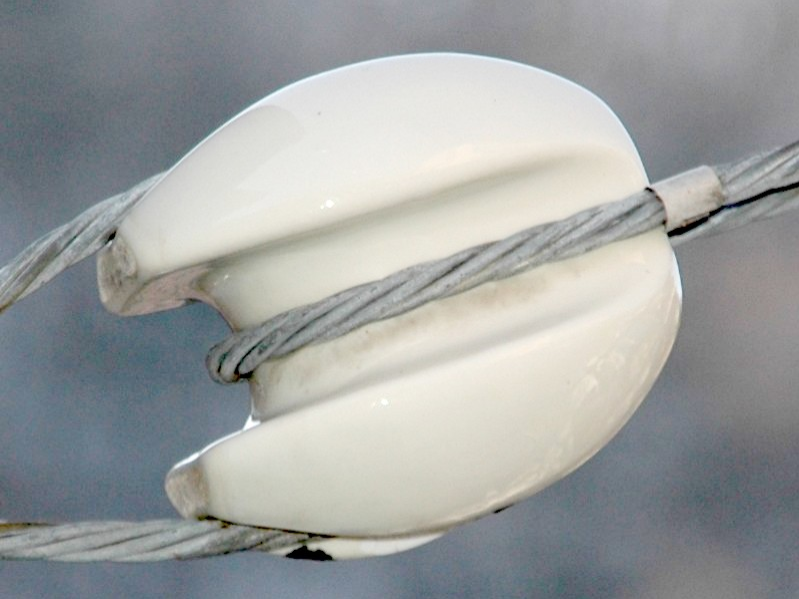| Vocademy |
Conductors
Electrons move freely through metals like air moves freely through a hose

|
Stranded Copper Wire |
In a mass of metal, the atoms form
metallic bonds. In a metallic bond,
the outer-most layer of electrons surrounding each atom (known as the
valence electrons or the valence shell) cannot fit into the crystal
structure. These valence electrons float around in the mass of metal
like a gas. If any force is exerted on these electrons, they will move
freely. This is like the air floating freely in a soda straw. If you
blow into one open end of a soda straw, the air inside will come out
the other end. Electrons flow in conductors much the same way.
Electricity flows more freely in metals that have fewer valence electrons. Copper is a good conductor because each copper atom has only one valence electron. Gold and silver also have only one valence electron per atom and are also good conductors. Aluminum has three valence electrons per atom and so is not as good a conductor as copper, gold or silver. Electrical wiring made from aluminum is typically made from a heavier gauge than equivalent copper wire.
The idea of superconductivity (zero resistance) implies that the smallest voltage would cause an infinite current. However, an infinite current would require an infinite number of electrons. Therefore, when a material is superconducting, any current flowing in the material will continue to flow, even when no voltage is applied.
Electricity flows more freely in metals that have fewer valence electrons. Copper is a good conductor because each copper atom has only one valence electron. Gold and silver also have only one valence electron per atom and are also good conductors. Aluminum has three valence electrons per atom and so is not as good a conductor as copper, gold or silver. Electrical wiring made from aluminum is typically made from a heavier gauge than equivalent copper wire.
Electrical wire
Electrical wire is made of good conductors and usually used just to carry electricity from one point to another. Electrical wire is generally made of copper, but aluminum and even silver and gold are sometimes used. Electrical wire is also usually insulated, usually with polyvinylchloride (PVC), polytetrafluoroethylene (PTFE or Teflon®), or Enamel.Wire size is measured in "gauge"
In North America, the diameter of electrical wire is usually measured in a unit called gauge (AWG or American Wire Gauge). Wire with a higher gauge number is smaller than wire with a lower number. For example, 8 gauge wire is about 1/8 inch in diameter. 0 gauge wire is about 1/3 inch in diameter.More electricity through a thick wire than a thin wire
Just as more water can be pumped through a large-diameter pipe than a small-diameter pipe (assuming equal pressure), a large diameter wire can carry more electrical current than a small diameter wire (assuming equal voltage). Electrical resistance is how much a wire or component resists the flow of electricity. A large diameter wire has less resistance than a small diameter wire.More electricity through a short wire than a long wire
It takes more pressure to pump the same amount of water through a longer pipe than a shorter pipe. Likewise, it takes more voltage to push the same amount of electricity through a longer wire than a shorter wire. This demonstrates that a longer wire has more resistance than a shorter wire of the same diameter.More electricity through a cold wire than a hot wire
The resistance of a wire also increases as its temperature increases. Likewise, as the temperature decreases, the resistance decreases.How much current can a wire carry
The ability of a wire to carry current is called its ampacity. The acceptable temperature in a particular application determines the practical ampacity. The melting temperature of the insulation limits the practical ampacity of insulated wire.Superconductors
Most materials will have some resistance even at a temperature of absolute zero. However, certain materials, when cooled to extremely low temperatures, will lose all resistance. This is called superconductivity. Mercury will superconduct at 4.2 kelvins (-269 ºC). Niobium nitride will superconduct at 16 kelvins (-257 ºC). Until 1986 it was thought that superconductivity was impossible above a temperature of 30 kelvins (-243 ºC). After that year, materials that superconduct at higher temperatures were discovered. For example, yttrium barium copper oxide will superconduct at 77 kelvins (-196 ºC).The idea of superconductivity (zero resistance) implies that the smallest voltage would cause an infinite current. However, an infinite current would require an infinite number of electrons. Therefore, when a material is superconducting, any current flowing in the material will continue to flow, even when no voltage is applied.
Insulators
Electrons cannot move freely through most ceramics, glasses and plastics

|
An Electric Insulator |
In a mass of a non-metal, the atoms
form covalent bonds. In a covalent bond, the outer-most layer of
electrons is tightly bound into the crystal structure of the material.
When a metal bonds with a non-metal, the materials form an ionic bond The
outer-most layer of electrons is tightly bound into the crystal
structure in an ionic bond also. With the electrons tightly bound into
the crystal structure, it is difficult to cause them to move. Non-metals
and metal-non-metal compounds (such as metal oxides) tend to make poor
conductors. It is like trying to blow cement out of a soda straw.
Most non-metallic elements tend to be liquid or a gas at normal temperatures and pressures so are not practical for use as insulators. Insulators are usually made of polymers (plastics), glass or ceramics.
Insulators are used anywhere they are needed to prevent two conducting objects from coming in contact with each other. Normally, air makes a good insulator. However, if the voltage differential becomes high enough, the air between two conductors will ionize (some electrons are torn from their atoms) and become conductive. This results in sparks, such as lightning.
Most non-metallic elements tend to be liquid or a gas at normal temperatures and pressures so are not practical for use as insulators. Insulators are usually made of polymers (plastics), glass or ceramics.
Insulators are used anywhere they are needed to prevent two conducting objects from coming in contact with each other. Normally, air makes a good insulator. However, if the voltage differential becomes high enough, the air between two conductors will ionize (some electrons are torn from their atoms) and become conductive. This results in sparks, such as lightning.
Semiconductors
Semiconductors are a special class of materials that will be covered under solid state devices in another volume.
Summary:
The rules for conductors are:
- A thin wire has more resistance than a thick wire.
- A long wire has more resistance than a short wire.
- All other factors being equal, a thick wire will carry more current than a thin wire.
- All other factors being equal, a short wire will carry more current than a long wire.
- As the temperature of a wire increases, so does the resistance (and vice versa)
- Some materials have zero resistance below a certain temperature (superconductivity).
- Insulators do not conduct electricity under normal conditions.
Conductors and Insulators
| Vocademy |